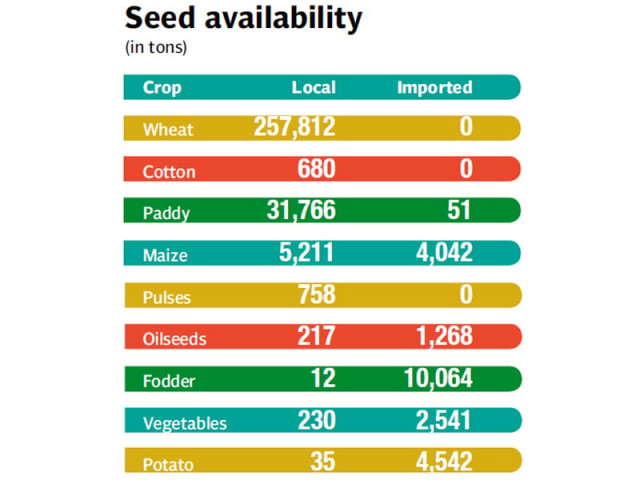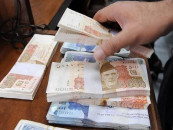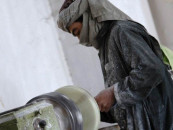Good seeds, high productivity remain a distant dream
Govt pays little attention towards the sector, which contributes the most to the GDP.

Govt pays little attention towards the sector, which contributes the most to the GDP.
Agriculture contributes over 21% to Pakistan’s gross domestic product (GDP) and employs 45% of its labour force. Take the major cotton crop and it alone adds 1.5% to the economy, feeding the textile industry and basically helping to run the manufacturing base. Last fiscal year, the crop was sown over 2.8 million hectares.
That would have required thousands of tons of seeds. But just 679.7 tons of government-certified and laboratory tested seeds were used. The rest came from unauthorised dealers!
Contrary to general perception, successive legislators have paid little attention to solving the problems inflicting the country’s agriculture. It does not matter if most of them derive their support from rural areas. As long as they make sufficient cash to support a certain living standards, there is little charm in going the extra mile.
Notwithstanding the cyclic impacts of bad weather and world prices, production of major crops has slowly increased over the years. Even the yields have improved. However, experts insist, that Pakistan remains far behind other developing countries when it comes to efficiency.
In 2012-13, Pakistan produced 13 million bales of cotton while per hectare yield was 769 kilogrammes (kgs), according to the Economic Survey of Pakistan 2013. “That’s very low compared to productivity of Indian farmers,” said Saleem Muhammad Bhullar, owner of Atom Seed Corporation. “Indians have double the per hectare yield compared to us.”
There are 766 registered seed companies yet their penetration is limited and seed availability remains an issue. “The unorganised distribution is doing more harm as immature varieties make their way to fields, damaging the crops,” he said.
Bhullar estimates that Pakistan can easily take up its cotton production to 25 million bales if the government decides to initiate serious steps. “We already have had success in case of wheat, which has been an improvement in terms of yield.”

Some reasons stop government from interfering too much in the agricultural market. Analysts argue that market forces continuously work to decide the prices and reward farmers who in turn decide which crop to sow and how much to spend. They cite the case of cotton, which is cultivated on a larger area in the year following the period when international prices shoot up.
But industry people point out that agriculture is subsidised everywhere from the United States to China and Islamabad’s half-hearted approach is damaging the sector.
It must be kept in mind that farmers who own over 80% of agricultural land are categorised as small landholders, having less than five acres.
“Yes, economics dictate that these farmers should be striving to make most out of their land by using the best seed and fertiliser on their own,” says Muhammad Ather Iqbal, chairman of the Seeds Association of Pakistan. “But what does that farmer do when there is no electricity to run the tube-well and when diesel is too expensive?”
Despite the fact that good-quality hybrid seeds are expensive because they are imported, policymakers have ignored all pleas to subsidise the supply.
“We have argued for so many years to give farmers some incentive for using good seeds. It is okay if the government cannot give direct subsidy, but at least make the supply chain tax free,” said Iqbal.
Industry people say narrow base of government’s tax revenue, which comes mostly from urban areas, make it difficult to set aside subsidy for agriculture. Even where the government intends to give subsidy, the distorted market conditions do not allow farmers to benefit.
Professor Dr Faqir Muhammad Anjum, director general of the University of Agriculture Faisalabad, says crop yields remain depressed mainly because of non-availability of farm inputs.
“Seed availability remains between 15% and 20%. Fertiliser and pesticide prices are too high compared to regional competitors,” he said. “It’s all an issue of mismanagement.”
Government subsidises fertilizer but industry people say farmers rarely get the right price. “In the end they pay much more than they should.”
Even the best efforts of powerful business lobbies which depend on agriculture have failed to bring in reforms. For years, Iskander M Khan, former chairman of Pakistan Sugar Mills Association, has been pushing for a pricing mechanism, which encourages production of good quality sugarcane.
“Everything has been done – all the presentations, approvals and legal formalities – yet the government doesn’t do it,” he said, explaining that recently the government announced the support price for 40kgs of sugarcane that the mills are bound to pay.
“What we want is price based on sugar recovery from sugarcane. It’s just like a simple equation that a good mango is expensive than a bad mango. That makes all the sense. When that happens farmers will strive to raise productivity,” he said. “But why hasn’t that happened? I don’t know.”
Published in The Express Tribune, August 19th, 2013.
Like Business on Facebook, follow @TribuneBiz on Twitter to stay informed and join in the conversation.



















COMMENTS
Comments are moderated and generally will be posted if they are on-topic and not abusive.
For more information, please see our Comments FAQ